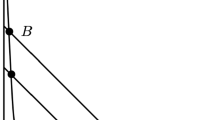Abstract
Chemical reaction systems are dynamical systems that arise in chemical engineering and systems biology. In this work, we consider the question of whether the minimal (in a precise sense) multistationary chemical reaction networks, which we propose to call ‘atoms of multistationarity,’ characterize the entire set of multistationary networks. Our main result states that the answer to this question is ‘yes’ in the context of fully open continuous-flow stirred-tank reactors (CFSTRs), which are networks in which all chemical species take part in the inflow and outflow. In order to prove this result, we show that if a subnetwork admits multiple steady states, then these steady states can be lifted to a larger network, provided that the two networks share the same stoichiometric subspace. We also prove an analogous result when a smaller network is obtained from a larger network by ‘removing species.’ Our results provide the mathematical foundation for a technique used by Siegal- Gaskins et al. of establishing bistability by way of ‘network ancestry.’ Additionally, our work provides sufficient conditions for establishing multistationarity by way of atoms and moreover reduces the problem of classifying multistationary CFSTRs to that of cataloging atoms of multistationarity. As an application, we enumerate and classify all 386 bimolecular and reversible two-reaction networks. Of these, exactly 35 admit multiple positive steady states. Moreover, each admits a unique minimal multistationary subnetwork, and these subnetworks form a poset (with respect to the relation of ‘removing species’) which has 11 minimal elements (the atoms of multistationarity).
Similar content being viewed by others
References
J. Bennett, AutoIt Team: AutoIt v3 (2010). Available at http://autoitscript.com/autoit3/index.shtml
Conradi C., Flockerzi D., Raisch J., Stelling J.: Subnetwork analysis reveals dynamic features of complex (bio)chemical networks. Proc. Natl. Acad. Sci. USA 104(49), 19,175–19,180 (2007)
Craciun G., Feinberg M.: Multiple equilibria in complex chemical reaction networks. I. The injectivity property. SIAM J. Appl. Math. 65(5), 1526–1546 (2005)
Craciun G., Feinberg M.: Multiple equilibria in complex chemical reaction networks: extensions to entrapped species models. IEE P. Syst. Biol. 153, 179–186 (2006)
Craciun G., Feinberg M.: Multiple equilibria in complex chemical reaction networks. II. The species-reaction graph. SIAM J. Appl. Math. 66(4), 1321–1338 (2006)
Craciun G., Feinberg M.: Multiple equilibria in complex chemical reaction networks: semiopen mass action systems. SIAM J. Appl. Math. 70(6), 1859–1877 (2010)
Craciun G., Helton J.W., Williams R.J.: Homotopy methods for counting reaction network equilibria. Math. Biosci. 216(2), 140–149 (2008)
A.C. Deckard, F.T. Bergmann, H.M. Sauro, Enumeration and online library of mass-action reaction networks (2009). Available at arXiv/0901.3067
P. Ellison, The advanced deficiency algorithm and its applications to mechanism discrimination. Ph.D. thesis, University of Rochester (1998)
P. Ellison, M. Feinberg, H. Ji, Chemical reaction network toolbox (2011). Available at http://www.che.eng.ohio-state.edu/~feinberg/crnt/
Feinberg M.: Chemical reaction network structure and the stability of complex isothermal reactors I. The deficiency zero and deficiency one theorems. Chem. Eng. Sci. 42(10), 2229–2268 (1987)
Feinberg M.: Chemical reaction network structure and the stability of complex isothermal reactors II. Multiple steady states for networks of deficiency one. Chem. Eng. Sci. 43(1), 1–25 (1988)
E. Feliu, C. Wiuf, Enzyme sharing as a cause of multistationarity in signaling systems. J. R. Soc. Interface 9(71), 1224–1232 (2011). doi:10.1098/rsif.2011.0664
Horn F., Jackson R.: General mass action kinetics. Arch. Ration. Mech. Anal. 47(2), 81–116 (1972)
H. Ji, Uniqueness of equilibria for complex chemical reaction networks. Ph.D. thesis, Ohio State University (2011)
B. Joshi, Complete classification of one-reaction atoms of multistationary (2012). arXiv/1207.6018
Joshi B., Shiu A.: Simplifying the Jacobian Criterion for precluding multistationarity in chemical reaction networks. SIAM J. Appl. Math 72(3), 857–876 (2012)
I. Klep, K. Fredrickson, B. Helton, Chemical reaction network software (under Mathematica) (2008). Available at http://www.math.ucsd.edu/~chemcomp/
C. Pantea, BioNetX (2010). Available at http://cap.ee.ic.ac.uk/~cpantea/
C. Pantea, G. Craciun, Computational methods for analyzing bistability in biochemical reaction networks, in Circuits and Systems (ISCAS), Proceedings of 2010 IEEE International Symposium on (2010), pp. 549–552. IEEE
Shiu A.: The smallest multistationary mass-preserving chemical reaction network. Lect. Notes Comput. Sc. 5147, 172–184 (2008)
Siegal-Gaskins D., Grotewold E., Smith G.: The capacity for multistability in small gene regulatory networks. BMC Syst. Biol. 3(1), 96 (2009)
Siegal-Gaskins D., Mejia-Guerra M.K., Smith G.D., Grotewold E.: Emergence of switch-like behavior in a large family of simple biochemical networks. PLoS Comput. Biol. 7(5), e1002–039 (2011)
Wilhelm T.: The smallest chemical reaction system with bistability. BMC Syst. Biol. 3, 90 (2009)
T. Wilhelm, R. Heinrich, Smallest chemical reaction system with Hopf bifurcation. J. Math. Chem. 17(1), 1–14 (1995). URL http://dx.doi.org/10.1007/BF01165134
Author information
Authors and Affiliations
Corresponding author
Rights and permissions
About this article
Cite this article
Joshi, B., Shiu, A. Atoms of multistationarity in chemical reaction networks. J Math Chem 51, 153–178 (2013). https://doi.org/10.1007/s10910-012-0072-0
Received:
Accepted:
Published:
Issue Date:
DOI: https://doi.org/10.1007/s10910-012-0072-0




